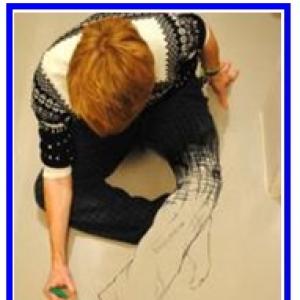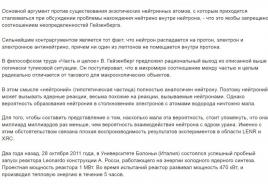Mechanics of deformable bodies. Deformable Solid Mechanics
The mechanics of a deformable solid is a science in which the laws of equilibrium and motion of solid bodies are studied under conditions of their deformation under various influences. The deformation of a solid is that its size and shape change. The engineer constantly encounters this property of solids as elements of structures, structures and machines in his practice. For example, a bar elongates under the action of tensile forces, a beam loaded with a transverse load bends, etc.
Under the action of loads, as well as under thermal influences, internal forces arise in solids, which characterize the resistance of the body to deformation. Internal forces per unit area are called stresses.
Investigation of the stressed and deformed states of solids under various influences is the main task of the mechanics of a deformable solid.
The resistance of materials, the theory of elasticity, the theory of plasticity, and the theory of creep are branches of the mechanics of a deformable solid. In technical, in particular construction, universities, these sections are of an applied nature and serve to develop and substantiate methods for calculating engineering structures and structures for strength, rigidity and sustainability. The correct solution of these problems is the basis for the calculation and design of structures, machines, mechanisms, etc., since it ensures their reliability throughout the entire period of operation.
Under strength usually means the ability to safely operate a structure, structure and their individual elements, which would exclude the possibility of their destruction. Loss (exhaustion) of strength is shown in Fig. 1.1 on the example of the destruction of a beam under the action of a force R.
The process of exhaustion of strength without changing the structure's work pattern or the form of its equilibrium is usually accompanied by an increase in characteristic phenomena, such as, for example, the appearance and development of cracks.
Structural stability - it is its ability to maintain the original form of balance until destruction. For example, for the bar in Fig. 1.2, and up to a certain value of the compressive force, the initial rectilinear form of equilibrium will be stable. If the force exceeds a certain critical value, then the curved state of the rod will be stable (Fig. 1.2, b). In this case, the rod will work not only in compression, but also in bending, which can lead to its rapid destruction due to loss of stability or to the appearance of unacceptably large deformations.
Loss of stability is very dangerous for structures and structures, as it can occur within a short period of time.
Structural rigidity characterizes its ability to prevent the development of deformations (elongations, deflections, torsion angles, etc.). Usually the rigidity of structures and structures is regulated by design standards. For example, the maximum deflections of beams (Fig. 1.3) used in construction should be within / \u003d (1/200 + 1/1000) /, the angles of twisting of shafts usually do not exceed 2 ° per 1 meter of shaft length, etc.
Solving the problems of structural reliability is accompanied by the search for the most optimal options in terms of the efficiency of work or operation of structures, material consumption, manufacturability of construction or manufacture, aesthetic perception, etc.


Resistance of materials in technical universities is essentially the first engineering discipline in the process of teaching in the field of design and calculation of structures and machines. The course on resistance of materials mainly describes methods for calculating the simplest structural elements - rods (beams, beams). At the same time, various simplifying hypotheses are introduced, with the help of which simple calculation formulas are derived.
In the strength of materials, methods of theoretical mechanics and higher mathematics, as well as data from experimental studies, are widely used. Strength of materials as a basic discipline is largely based on the disciplines studied by senior students, such as structural mechanics, building structures, structural testing, dynamics and strength of machines, etc.
The theory of elasticity, the theory of creep, and the theory of plasticity are the most general sections of the mechanics of a deformable solid. The hypotheses introduced in these sections are of a general nature and mainly relate to the behavior of the body material during its deformation under the action of a load.
The theories of elasticity, plasticity, and creep use as accurate or sufficiently rigorous methods as possible for the analytical solution of problems, which requires the involvement of special branches of mathematics. The results obtained here allow one to give methods for calculating more complex structural elements, for example, plates and shells, to develop methods for solving special problems, such as, for example, the problem of stress concentration near holes, and also to establish the areas of application of solutions for the resistance of materials.
In cases where the mechanics of a deformable solid cannot provide methods for calculating structures that are sufficiently simple and accessible for engineering practice, various experimental methods for determining stresses and strains in real structures or in their models are used (for example, the tensometric method, the polarization-optical method, the holography, etc.).
The formation of resistance of materials as a science can be attributed to the middle of the last century, which was associated with the intensive development of industry and the construction of railways.
Requests from engineering practice gave impetus to research in the field of strength and reliability of structures, structures and machines. During this period, scientists and engineers developed fairly simple methods for calculating structural elements and laid the foundations for the further development of the science of strength.
The theory of elasticity began to develop at the beginning of the 19th century as a mathematical science that has no applied nature. The theory of plasticity and the theory of creep as independent sections of the mechanics of a deformable solid were formed in the XX century.
The mechanics of a deformable solid is a constantly developing science in all its branches. New methods for determining the stressed and deformed states of bodies are being developed. Various numerical methods for solving problems are widely used, which is associated with the introduction and use of computers in almost all areas of science and engineering practice.
Lecture number 1
Strength of materials as a scientific discipline.
Schematization of structural elements and external loads.
Assumptions about material properties of structural members.
Internal forces and tensions
Section method
Displacement and deformation.
Superposition principle.
Basic concepts.
Resistance of materials as a scientific discipline: strength, rigidity, stability. Design scheme, physical and mathematical model of the operation of an element or part of a structure.
Schematization of structural elements and external loads: timber, bar, beam, plate, shell, massive body.
External forces: volumetric, surface, distributed, concentrated; static and dynamic.
Assumptions about material properties of structural elements: material is solid, homogeneous, isotropic. Body deformation: elastic, residual. Material: linear elastic, nonlinear elastic, elastoplastic.
Internal forces and stresses: internal forces, normal and shear stresses, stress tensor. Expression of internal forces in the cross-section of the bar in terms of stresses i am.
Section method: determination of the components of internal forces in the section of the bar from the equilibrium equations of the separated part.
Displacements and deformations: displacement of a point and its components; linear and angular deformations, strain tensor.
Superposition principle: geometrically linear and geometrically nonlinear systems.
Strength of materials as a scientific discipline.
The disciplines of the strength cycle: resistance of materials, theory of elasticity, structural mechanics are united under the general name " Rigid Deformable Body Mechanics».
Strength of materials is the science of strength, stiffness and stability elements engineering structures.
Design it is customary to call a mechanical system of geometrically unchangeable elements, relative movement of points which is possible only as a result of its deformation.
Under the strength of structures understand their ability to resist destruction - separation into parts, as well as irreversible change in shape under the influence of external loads .
Deformation Is a change relative position of body particles associated with their movement.
Rigidity Is the ability of a body or structure to resist deformation.
Stability of the elastic system call its property to return to a state of equilibrium after small deviations from this state .
Elasticity - this is the property of the material to completely restore the geometric shape and dimensions of the body after removing the external load.
Plastic - this is the property of solids to change their shape and size under the action of external loads and to maintain it after removing these loads. Moreover, the change in the shape of the body (deformation) depends only on the applied external load and does not happen by itself over time.
Creep - this is the property of solids to deform under the influence of a constant load (deformations grow with time).
Construction mechanics call science about calculation methods structures for strength, rigidity and stability .
1.2 Schematization of structural elements and external loads.
Design model it is customary to call an auxiliary object that replaces the real structure, presented in its most general form.
Resistance of materials uses design schemes.
Calculation scheme - this is a simplified image of a real structure, which is freed from its insignificant, secondary features and which accepted for mathematical description and calculation.
The main types of elements, into which the whole structure is subdivided in the design scheme, are: timber, bar, plate, shell, massive body.
Fig. 1.1 Basic types of structural elements
Bar Is a solid, obtained by moving a flat figure along a guideline so that its length is significantly greater than the other two dimensions.
Rod called rectilinear beam, which works in tension / compression (significantly exceeds the characteristic dimensions of the cross section h, b).
The locus of the points that are the centers of gravity of the cross sections will be called rod axis .
Plate Is a body whose thickness is significantly less than its dimensions a and b in respect of.
The naturally curved plate (the curve before loading) is called shell .
Massive body characteristic in that all its sizes a ,b, and chave the same order.
Fig. 1.2 Examples of bar structures.
Beam is called a beam that experiences bending as the main method of loading.
Farm called a set of pivotally connected rods .
Frame – it is a set of beams rigidly connected to each other.
External loads subdivide on the focused and distributed .
Figure 1.3 Schematization of the crane girder operation.
Force or moment, which are conventionally considered to be attached at a point, are called focused .
Figure 1.4 Volume, surface and distributed loads.
Load, constant or very slowly varying in time, when the speeds and accelerations of the resulting motion can be neglected, called static.
A rapidly changing load is called dynamic , calculation taking into account the arising oscillatory motion - dynamic calculation.
Assumptions about material properties of structural members.
In the resistance of materials, a conditional material is used, endowed with certain idealized properties.
In fig. 1.5 depicts three characteristic deformation diagrams connecting the values \u200b\u200bof the force F and deformation at loading and unloading.
Fig. 1.5 Typical material deformation diagrams
Full deformation consists of two components, elastic and plastic.
The part of the total deformation that disappears after removing the load is called elastic .
The deformation remaining after unloading is called residual or plastic .
Elastic - plastic material Is a material that exhibits elastic and plastic properties.
A material in which only elastic deformations occur is called perfectly elastic .
If the deformation diagram is expressed by a nonlinear dependence, then the material is called nonlinear elastic, if linear dependence , then linearly elastic .
The material of structural elements will be further considered solid, homogeneous, isotropic and linearly elastic.
Property continuity means that the material continuously fills the entire volume of the structural element.
Property uniformity means that the entire volume of the material has the same mechanical properties.
The material is called isotropic if its mechanical properties are the same in all directions (otherwise anisotropic ).
The correspondence of the conditional material to real materials is achieved by the fact that experimentally obtained averaged quantitative characteristics of the mechanical properties of materials are introduced into the calculation of structural elements.
1.4 Internal forces and tensions
Internal forces – the increment of the forces of interaction between the particles of the body arising during its loading .
Fig. 1.6 Normal and shear stresses at a point
The body is dissected by a plane (Fig. 1.6 a) and in this section at the point under consideration M a small area is selected, its orientation in space is determined by the normal n... The resultant force on the site is denoted by. Average the intensity on the site is determined by the formula. The intensity of internal forces at a point is defined as the limit
(1.1) The intensity of internal forces transmitted at a point through a dedicated area is called voltage at this site .
Voltage dimension .
The vector determines the total voltage at a given site. We decompose it into its components (Figure 1.6 b) so that, where and are respectively normal and tangent stresses at the site with normal n.
When analyzing stresses in the vicinity of the considered point M(Figure 1.6 c) an infinitesimal parallelepiped-shaped element with sides dx, dy, dz is distinguished (6 sections are drawn). The total stresses acting on its faces are decomposed into normal and two shear stresses. The set of stresses acting on the edges is represented in the form of a matrix (table), which is called stress tensor
The first index of the voltage, for example , shows that it acts on an area with a normal parallel to the x axis, and the second shows that the stress vector is parallel to the y axis. For normal stress, both indices coincide, therefore one index is put.
Force factors in the cross-section of the bar and their expression in terms of stresses.
Consider the cross-section of the bar of the loaded bar (Figure 1.7, a). Internal forces distributed over the section are reduced to the main vector R applied at the center of gravity of the section and the main moment M... Further, we decompose them into six components: three forces N, Qy, Qz and three moments Mx, My, Mz, called internal forces in the cross section.
Fig. 1.7 Internal forces and stresses in the cross section of the bar.
The components of the main vector and the main moment of internal forces distributed over the section are called internal forces in the section (N- longitudinal force ; Qy, Qz- lateral forces , Mz, My- bending moments , Mx- torque) .
Let us express the internal forces in terms of the stresses acting in the cross section, assuming they are known at every point (Fig. 1.7, c)
Expression of internal efforts through stress i am.
![]() (1.3)
(1.3)
1.5 Section method
When external forces act on the body, it is deformed. Consequently, the mutual arrangement of body particles changes; as a result, additional forces of interaction between particles arise. These forces of interaction in a deformed body are internal efforts... You must be able to determine meanings and directions of internal efforts through external forces acting on the body. For this is used section method.
Fig. 1.8 Determination of internal forces by the section method.
Equilibrium equations for the remainder of the bar.
From the equilibrium equations, we determine the internal forces in the section a-a.
1.6 Displacement and deformation.
Under the action of external forces, the body is deformed, i.e. changes its size and shape (Figure 1.9). Some arbitrary point M moves to a new position M 1. The total displacement of MM 1 will be
decompose into components u, v, w, parallel to the coordinate axes.
Fig 1.9 Full movement of a point and its components.
But the movement of this point does not yet characterize the degree of deformation of the material element at this point (example of bending of a beam with a cantilever) .
Let's introduce the concept deformations at a point as a quantitative measure of material deformation in its vicinity . Let's select in the vicinity of point M an elementary parallelepiped (Fig. 1.10). Due to deformation, the length of its ribs will be elongated.
Figure 1.10 Linear and angular deformations of a material element.
Linear relative deformations at a point defined like this ():
In addition to linear deformations, angular deformations or shear angles, representing small changes in the initially right angles of the parallelepiped(for example, in the xy plane it will be). The shear angles are very small and of the order of magnitude.
The introduced relative deformations at the point are reduced to the matrix
 . (1.6)
. (1.6)
The quantities (1.6) quantitatively determine the deformation of the material in the vicinity of the point and constitute the deformation tensor.
Superposition principle.
A system in which internal forces, stresses, deformations and displacements are directly proportional to the acting load is called linearly deformable (the material works as linearly elastic).
Bounded by two curved surfaces, distance ...
The tasks of science
This is the science of strength and flexibility (stiffness) of elements of engineering structures. Practical calculations are carried out using the methods of deformable body mechanics and reliable (strong, stable) dimensions of machine parts and various building structures are determined. The introductory, initial part of the mechanics of a deformable body is the course, called strength of materials... The main provisions of the resistance of materials are based on the laws of general rigid body mechanics and, first of all, on the laws of statics, the knowledge of which is absolutely necessary for studying the mechanics of a deformable body. The mechanics of deformable bodies also includes other sections, such as the theory of elasticity, the theory of plasticity, and the theory of creep, where the same issues are considered as in the resistance of materials, but in a more complete and rigorous formulation.
The resistance of materials sets as its task the creation of practically acceptable and simple methods for calculating the strength and stiffness of typical, most common structural elements. In this case, various approximate methods are widely used. The need to bring the solution of each practical problem to a numerical result forces us to resort in some cases to simplifying hypotheses, assumptions, which are justified in the future by comparing the calculated data with experiment.
General approach
It is convenient to consider many physical phenomena using the scheme shown in Figure 13:
Through X here some action (control) applied to the input of the system is indicated AND (machine, test sample of material, etc.), and after Y - the reaction (response) of the system to this impact. We will assume that the reactions Y removed from the system output AND.
Under the managed system AND let us agree to understand any object capable of deterministically reacting to some influence. This means that all copies of the system AND under the same conditions, i.e. under the same influences x (t), behave strictly the same, i.e. give out the same y (t)... Such an approach, of course, is only a certain approximation, since it is practically impossible to obtain neither two completely identical systems, nor two identical influences. Therefore, strictly speaking, one should consider not deterministic, but probabilistic systems. Nevertheless, for a number of phenomena it is convenient to ignore this obvious fact and consider the system deterministic, understanding all quantitative relationships between the quantities under consideration in the sense of relationships between their mathematical expectations.
The behavior of any deterministic controlled system can be determined by some relation connecting the output with the input, i.e. x from at... This relation will be called the equation fortunes systems. This is symbolically written as follows
where is the letter AND, used earlier to denote a system, can be interpreted as some operator that allows you to determine y (t)if given x (t).
The introduced concept of a deterministic system with input and output is very general. Here are some examples of such systems: an ideal gas, the characteristics of which are related by the Mendeleev-Clapeyron equation, an electrical circuit that obeys one or another differential equation, a steam or gas turbine blade deformed in time by forces acting on it, etc. Our goal is not the study of an arbitrary controlled system, and therefore in the course of presentation we will introduce the necessary additional assumptions, which, by limiting the generality, will allow us to consider a system of a particular type that is most suitable for modeling the behavior of a body deformable under load.
The analysis of any controlled system can, in principle, be carried out in two ways. The first one microscopic, based on a detailed study of the structure of the system and the functioning of all its constituent elements. If all this can be done, then it becomes possible to write the equation of state of the entire system, since the behavior of each of its elements and the ways of their interaction are known. So, for example, the kinetic theory of gases allows you to write the Mendeleev-Clapeyron equation; knowledge of the device of an electrical circuit and all its characteristics makes it possible to write its equations based on the laws of electrical engineering (Ohm's law, Kirchhoff's law, etc.). Thus, the microscopic approach to the analysis of a controlled system is based on the consideration of the elementary processes that make up this phenomenon, and, in principle, is capable of giving a direct comprehensive description of the system under consideration.
However, the micro-approach cannot always be implemented due to the complex or not yet studied structure of the system. For example, at present it is not possible to write the equation of state of a deformable body, no matter how carefully it is studied. The same applies to more complex phenomena occurring in a living organism. In such cases, the so-called macroscopic phenomenological (functional) approach, in which they are not interested in the detailed structure of the system (for example, the microscopic structure of a deformable body) and its elements, but study the functioning of the system as a whole, which is considered as a connection between input and output. Generally speaking, this relationship can be arbitrary. However, for each specific class of systems, general restrictions are imposed on this connection, and carrying out a certain minimum of experiments may be sufficient to clarify this connection with the necessary details.
The use of the macroscopic approach is, as already noted, forced in many cases. Nevertheless, even the creation of a consistent micro-theory of a phenomenon cannot completely devalue the corresponding macro-theory, since the latter is based on experiment and therefore is more reliable. Microtheory, when constructing a model of a system, is always forced to make some simplifying assumptions, leading to various kinds of inaccuracies. For example, all "microscopic" equations of state for an ideal gas (Mendeleev-Clapeyron, Van der Waals, etc.) have irreparable discrepancies with experimental data on real gases. The corresponding "macroscopic" equations based on these experimental data can describe the behavior of a real gas as accurately as you like. Moreover, the micro-approach is such only at a certain level - the level of the system under consideration. At the level of the elementary parts of the system, however, it is still a macro-approach, so that microanalysis of a system can be considered as a synthesis of its component parts, analyzed macroscopically.
Since at present the micro-approach is not yet able to lead to the equation of state of a deformable body, it is natural to solve this problem macroscopically. We will adhere to this point of view in the future.
Displacements and deformations
A real rigid body, deprived of all degrees of freedom (the ability to move in space) and under the influence of external forces, deformed... By deformation we mean a change in the shape and size of the body associated with the movement of individual points and elements of the body. In the strength of materials, only such movements are considered.
Distinguish between linear and angular movements of individual points and body elements. These displacements correspond to linear and angular deformations (relative elongation and relative shear).
Deformations are divided into elasticdisappearing after removing the load, and residual.
Hypotheses about a deformable body.Elastic deformations are usually (in any case, in structural materials such as metals, concrete, wood, etc.) insignificant, therefore, the following simplifying provisions are accepted:
1. The principle of initial dimensions. In accordance with it, it is assumed that the equilibrium equations for a deformable body can be drawn up without taking into account changes in the shape and dimensions of the body, i.e. as for an absolutely rigid body.
2. The principle of independence of action of forces. In accordance with it, if a system of forces (several forces) is applied to the body, then the action of each of them can be considered independently of the action of the remaining forces.
Voltage
Under the action of external forces, internal forces arise in the body, which are distributed over the sections of the body. To determine the measure of internal forces at each point, the concept is introduced stresses... Stress is defined as the internal force per unit cross-sectional area of \u200b\u200bthe body. Let the elastically deformed body be in equilibrium under the action of a certain system of external forces (Fig. 1). Through a dot (for example, k), in which we want to determine the tension, an arbitrary section is mentally made and a part of the body is discarded (II) .In order for the rest of the body to be in equilibrium, instead of the discarded part, internal forces must be applied. The interaction of the two parts of the body occurs at all points of the section, and therefore the internal forces act over the entire area of \u200b\u200bthe section. In the vicinity of the point under study, select the area dА... We denote the resultant internal forces on this site dF... Then the stress in the vicinity of the point will be (by definition)
N / m 2.
Stress has the dimension of force divided by area, N / m 2.
At a given point of the body, the stress has many values, depending on the direction of the sections, of which many can be drawn through the point. Therefore, when speaking about stress, it is necessary to indicate the cross section.


In the general case, the stress is directed at a certain angle to the section. This total voltage can be decomposed into two components:
1. Perpendicular to the section plane - normal voltage s.
2. Lying in the section plane - shear stress t.
Determination of stresses.The problem is solved in three stages.
1. Through the point under consideration, a section is drawn in which they want to determine the stress. One part of the body is thrown away and its action is replaced by internal forces. If the whole body is in balance, then the rest should also be in balance. Therefore, for the forces acting on the considered part of the body, it is possible to compose the equilibrium equations. These equations will include both external and unknown internal forces (stresses). Therefore, we write them in the form

The first terms are the sums of the projections and the sums of the moments of all external forces acting on the part of the body remaining after the section, and the second are the sums of the projections and moments of all internal forces acting in the section. As already noted, these equations include unknown internal forces (stresses). However, to determine them, the equations of statics not enough, since otherwise the difference between an absolutely rigid and a deformable body disappears. Thus, the problem of determining stresses is statically undefined.
2. To draw up additional equations, the displacements and deformations of the body are considered, as a result of which the law of stress distribution over the section is obtained.
3. By solving together the equations of statics and the equations of deformation, it is possible to determine the stresses.
Power factors. Let us agree to call the sum of projections and the sum of moments of external or internal forces power factors... Consequently, the force factors in the section under consideration are defined as the sum of the projections and the sum of the moments of all external forces located on one side of this section. In the same way, the force factors can be determined by the internal forces acting in the considered section. Force factors determined by external and internal forces are equal in magnitude and opposite in sign. Usually, in problems, external forces are known, through which the force factors are determined, and the stresses are already determined from them.
Deformable body model
In resistance of materials, a model of a deformable body is considered. The body is assumed to be deformable, solid, and isotropic. In the strength of materials, mainly bodies in the form of rods (sometimes plates and shells) are considered. This is due to the fact that in many practical problems the structure diagram is reduced to a straight bar or to a system of such rods (trusses, frames).
The main types of the deformed state of the rods. A rod (bar) is a body in which two sizes are small compared to the third (Fig. 15).
Consider a rod in equilibrium under the action of forces applied to it, arbitrarily located in space (Fig. 16).

Draw a section 1-1 and discard one part of the rod. Consider the balance of the remainder. We will use a rectangular coordinate system, for the origin of which we will take the center of gravity of the cross section. Axis X directed along the bar towards the outer normal to the section, the axis Y and Z - the main central axes of the section. Using the equations of statics, we find the force factors
 three forces
three forces
 three moments or three pairs of forces
three moments or three pairs of forces
Thus, in the general case, six force factors arise in the cross section of the rod. Depending on the nature of the external forces acting on the bar, various types of bar deformation are possible. The main types of bar deformations are stretching, compression, shift, torsion, bend... Accordingly, the simplest loading schemes are as follows.
Stretch-compression. Forces are applied along the axis of the rod. Discarding the right side of the bar, select the force factors by the left external forces (Fig. 17)

We have one nonzero factor - the longitudinal force F.
We build a diagram of power factors (diagram).
Torsion of the rod. In the planes of the end sections of the bar, two equal and opposite pairs of forces are applied with the moment M cr \u003d Tcalled torque (fig. 18).

As you can see, only one force factor acts in the cross section of the twisted bar - the moment T \u003d F h.
Transverse bending. It is caused by forces (concentrated and distributed) perpendicular to the beam axis and located in a plane passing through the beam axis, as well as by pairs of forces acting in one of the main planes of the bar.
The beams are supported, i.e. are non-free bodies, a typical support is a hinged-movable support (Fig. 19).

Sometimes a beam is used with one embedded and the other free end - a cantilever beam (Fig. 20).


Consider the definition of force factors using the example of Figure 21a. First you need to find the reactions of the supports R A and.
BASIC CONCEPTS OF MECHANICS
DEFORMABLE SOLID
This chapter presents the basic concepts that were previously studied in the courses of physics, theoretical mechanics and strength of materials.
1.1. Subject of Solid Mechanics
The mechanics of a deformable rigid body is the science of the balance and motion of rigid bodies and their individual particles, taking into account changes in the distances between individual points of a body that arise as a result of external influences on a rigid body. The mechanics of a deformable rigid body is based on the laws of motion discovered by Newton, since the speeds of motion of real rigid bodies and their individual particles relative to each other are significantly less than the speed of light. In contrast to theoretical mechanics, changes in the distances between individual particles of the body are considered here. The latter circumstance imposes certain restrictions on the principles of theoretical mechanics. In particular, in the mechanics of a deformable solid, the transfer of points of application of external forces and moments is inadmissible.
The analysis of the behavior of deformable solids under the influence of external forces is carried out on the basis of mathematical models reflecting the most significant properties of deformable solids and materials from which they are made. In this case, to describe the properties of the material, the results of experimental studies are used, which served as the basis for creating models of the material. Depending on the material model, the mechanics of a deformable solid is divided into sections: the theory of elasticity, the theory of plasticity, the theory of creep, and the theory of viscoelasticity. In turn, the mechanics of a deformable solid is part of a more general part of mechanics - the mechanics of continuous media. Continuum mechanics, being a branch of theoretical physics, studies the laws of motion of solid, liquid and gaseous media, as well as plasma and continuous physical fields.
The development of the mechanics of a deformable solid is largely associated with the tasks of creating reliable structures and machines. The reliability of the structure and machine, as well as the reliability of all their elements, is ensured by strength, rigidity, stability and endurance during the entire service life. Strength is understood as the ability of a structure (machine) and all its (her) elements to maintain their integrity under external influences without dividing into previously not provided parts. With insufficient strength, the structure or its individual elements are destroyed by dividing a single whole into parts. The rigidity of a structure is determined by the measure of the change in the shape and size of the structure and its elements under external influences. If the changes in the shape and size of the structure and its elements are not large and do not interfere with normal operation, then such a structure is considered sufficiently rigid. Otherwise, the rigidity is considered insufficient. The stability of a structure is characterized by the ability of the structure and its elements to maintain their form of equilibrium under the action of random forces not provided for by the operating conditions (disturbing forces). A structure is in a stable state if, after eliminating the disturbing forces, it returns to its original form of equilibrium. Otherwise, the loss of stability of the initial form of equilibrium occurs, which, as a rule, is accompanied by the destruction of the structure. Endurance refers to the ability of a structure to resist the effects of time-varying forces. Variable forces cause the growth of microscopic cracks inside the structure material, which can lead to the destruction of structural elements and the structure as a whole. Therefore, to prevent destruction, it is necessary to limit the magnitude of the time-variable forces. In addition, the lowest frequencies of natural vibrations of the structure and its elements should not coincide (or be close to) with the vibration frequencies of external forces. Otherwise, the structure or its individual elements enter into resonance, which can cause destruction and destruction of the structure.
The overwhelming majority of research in the field of solid mechanics is aimed at creating reliable structures and machines. This includes issues of design of structures and machines and problems of technological processes of processing materials. But the scope of application of solid mechanics is not limited to technical sciences alone. Its methods are widely used in natural sciences such as geophysics, solid state physics, geology, biology. So in geophysics, using the mechanics of a deformable solid, the processes of propagation of seismic waves and the processes of formation of the earth's crust are studied, fundamental questions of the structure of the earth's crust are studied, etc.
1.2. General properties of solids
All solids are made up of real materials with a wide variety of properties. Of these, only a few are essential for the mechanics of a deformable solid. Therefore, the material is endowed with only those properties that make it possible to study the behavior of solids at the lowest cost within the framework of the science under consideration.







